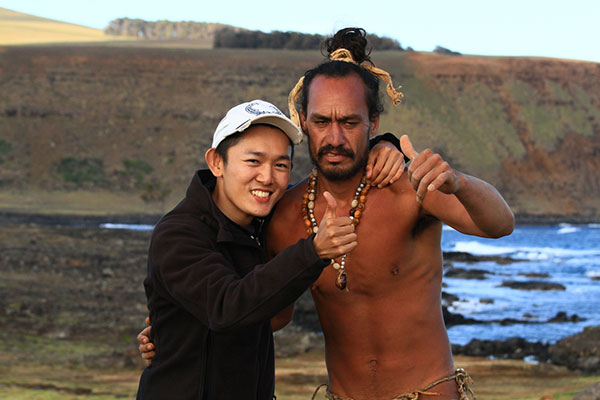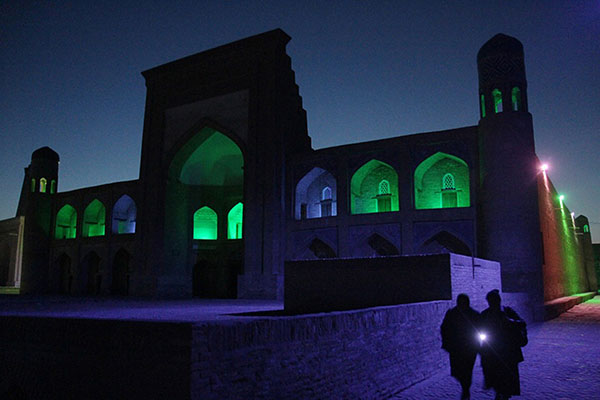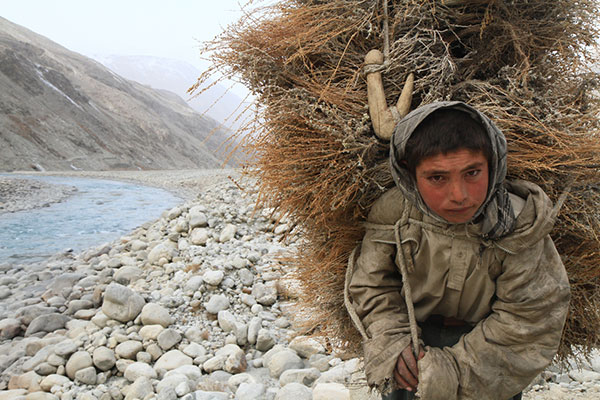
Kong with islander Mia who lives in the traditional lifestyle of Easter Island by catching fish, growing crops, and dressing the old way – Ahu Tongariki on Easter Island, Chile.
SIBU: St Augustine of Hippo said: “The world is a book and those who do not travel read only one page.”
That quote has become Kong Chek Yong’s motto and part of his great adventure story where his passions and emotions were aroused by his five senses.
This 33-year-old travel photographer from Sibu had been doing this for 12 years, traversing 95 countries and territories including Afghanistan, Antarctica, Cuba, Thailand, Georgia, Iran and Kosovo.
“There is so much beauty to be found in every corner of the world, and I cannot see enough of that,” he said in an interview recently.
Kong, a former Catholic High School student had never dreamed of being a traveller as there was no one around him to show him that it could be done.
As a young boy, he had been fascinated by adventure stories including Jules Verne ‘Around The World In 80 Days’. He loved reading and looking at the different cultural and geographical backdrops.
“It was only after I went to Singapore where I met normal backpackers and crazy backpackers who had taken long breaks to see the world that I reflected and thought I could make it too,” he said.
Kong pursued tertiary education in National University of Singapore (NUS) with a major in Applied Statistics after finishing high school. He has lived in Singapore ever since.
Kong’s interest in photography started in 2003 when he borrowed his friend’s cheap point-and-shoot film camera during his first backpacking trip in Taiwan.
He took his first photos and thinking they were not bad, decided to share them with a professional photographer only to receive some harsh criticisms.
He was still searching for a career path when he chanced on a advertisement put up by a professional photographer looking for an assistant.
“I went for the interview with my not-so-flattering Taiwan photos as portfolio and was turned down immediately. I couldn’t answer any of his questions on photography knowledge.
“I asked for opinion on my portfolio in the hope that he would mention my hidden talent. However, his criticism totally smashed my confidence. He said my focus, exposure and composition were off; and showed me a similar shot he took that was 100 times better. I left his studio, discouraged,” he recalled.
But he wanted to prove his critic wrong so decided to use his last bit of savings to make a solo backpacking trip to Laos, Cambodia and Thailand to cheer himself up. His friends bought him a low end digital camera as a birthday present.
“I spent a lot of time thinking of ways to refine my photos and to prove my critics wrong. When I came back from my trip, I showed the photos to my friends, and they were impressed. Some encouraged me to take it to professional level, but my skills were not polished yet,” he pointed out.
The encouragement prompted him to work harder. He upgraded to a semi-professional camera, then professional camera with good lenses. He started to read books on photography, browsing through National Geographic and using references on masters’ works.
His favourite photographers include Nat Geo photographer Steve McCurry and Vanity Fair lead photographer Annie Leibovitz.
“I signed up for a short course with a famous local photographer to learn his approach on documentation photography,” he said.

At night, alien illumination and moonlit silhouettes of the tilting columns and madrassas works its magic in the twisting alleyways of 1,200-year-old Khiva. This first Unesco heritage of Uzbekistan situated in the oasis preserves the glory of the Khanate kingdom renowned for their slave caravans, barbaric cruelty and steppes infested with wild tribesmen – Khiva, Uzbekistan.
Today Kong works with Facebook for China’s games export marketing business. He has 35,000 fans on his page with strangers asking him how to make a living out of travel photography.
In fact, Kong did not make a living from this hobby nor was he featured regularly.
“The only feature was from a Georgian (country) online magazine. The writer chanced upon my Facebook travel photography fan page and approached me. The only publicity I have been doing is posts on my fan page. As a Facebook employee, I needed to familiarise myself with the Facebook product,” he said.
Another achievement was his snap of an Afghanistan boy carrying firewood which a National Geographic editor had marked his ‘favourite’ on their website. He hoped to reduce negative perceptions of the world through photography.
“In my photos, I tell viewers that people in this world are basically the same as we share the same love, joy and struggle.”
He said being a traveller had changed his perception of the world, and made him grateful for the things he had.
“The genuine smiles I photographed in poor countries remind me of how lucky I am. Not only should I be grateful for what I have, but I am able to travel to so many countries which most people can only dream about.”
There were many things he could not capture on camera; experiences that he could only feel and appreciate. Those were stories of people.
“I met an Afghanistan refugee friend, jobless and discriminated, seeking second refugee status by escaping to neighbouring Turkey only to be in a worst situation as they were placed in a small house with 200 refugees after a three-day bus ride to a remote and poor village. My friend had to obtain a fake medical report to get out to a better city,” he said.
He also shared about a high ranking Iraqi militant on a good salary yet seeking refugee status after witnessing a team mate killing entire bunkmates to show his support for the Talibans.
“A stranger chatted with me in Hafiz-the-poet’s tomb in Iran and we realises we shared so much in common – interest in music, philosophy and art despite age and cultural differences.
“He gave me free rides, provided me a free bed, cooked me free meals and showed me an underground culture completely different from that of conservative society,” he recalled.
Kong rarely had problem communicating and bonding with his subjects but language can be a problem to get into countries unfriendly to foreigners.
He said sometimes he experienced ‘traveller fatigue’ from a long trip but he loved it and would travel until his last breath.
On how to follow in his footsteps, he said the most important thing was to take care of the bank account first.
“Your first 20 countries may appear cheap, but once you finish with countries like India, Cambodia and Thailand, the remaining ones will get more and more expensive,” he said.
He said they might find a US$5 room in Cambodia, but a room in Haiti would cost US$100 to avoid the risk of getting shot easily.
“Don’t be surprised that travelling in Africa is more expensive than Europe or US and when you venture to some very remote places, there is no compromise on cost,” he said.
On his plans for the future, he said he was thinking of going to places like North Korea, Southern Africa, Southern Asia (India, Pakistan, Nepal), Middle East and Bamiyan Valley in Afghanistan.

Young boy bring home weeds for cooking and keeping warm. In the valley where vegetation is hard to come by, only weeds (instead of tree brunches) are available – Wakhan Valley, Afghanistan.
